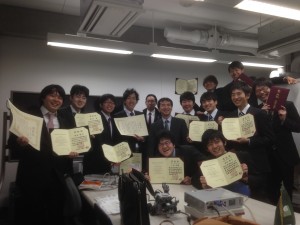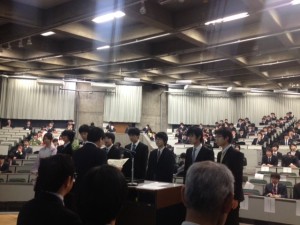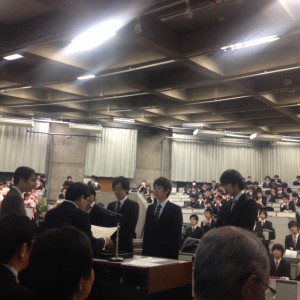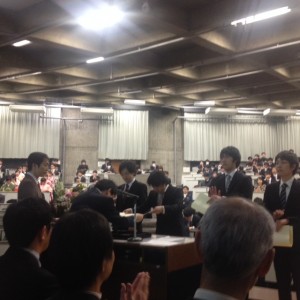Today, 7 undergraduates (M0/B4) joined our lab. Welcome!
鷲崎研より13名が卒業・修了。伊永君・角谷君が専攻賞(本賞)受賞、津村君が学部長賞受賞。
Network Analysis for Software Patterns including Organizational Patterns in Portland Pattern Repository accepted at Agile 2014 as short paper and research lightning talk.
Hironori Washizaki, Masashi Kadoya, Yoshiaki Fukazawa and Takeshi Kawamura, “Network Analysis for Software Patterns including Organizational Patterns in Portland Pattern Repository,” Proceedings of the Agile 2014 Conference, pp.XX-YY, Orlando, USA, July 28 – August 1, 2014. (to appear) (Agile2014-Pattern-Network-Analysis-camera-ready.pdf)
Software pattern is a general reusable solution to a commonly occurring problem within a given context while software development and management. Among various software patterns, organizational patterns are known as the basis for Agile software development movement, especially for Scrum and Extreme Programming. Patterns usually form a network having relationships among them to support users understand and utilize patterns efficiently and effectively. However little is known about the nature of such pattern networks, such as how are organizational patterns different from other patterns from the viewpoint of centrality. To clarify such characteristics of pattern networks and organizational patterns, we mine a network consisting 285 patterns from an existing world-largest online pattern repository called Portland Pattern Repository (PPR). By applying network analysis techniques to the mined network and careful review of the result, we revealed several interesting characteristics of the pattern network and organizational patterns.
Security Requirements Analysis using Knowledge in CAPEC accepted at WISSE 2014 (CAiSE Workshop).
Haruhiko Kaiya, Sho Kouno, Shinpei Ogata, Takuo Okubo, Nobukazu Yoshioka, Hironori Washizaki and Kenji Kaijiri, “Security Requirements Analysis using Knowledge in CAPEC,” Proceedings of the 4th International Workshop on Information Systems Security Engineering (WISSE 2014), pp.XX-YY, Thessaloniki, Greece, June 17, 2014. (to appear)
研究室オープンハウス 3月25, 27-28日
以下の日程で63号館5階0523室にてオープンハウスを開催しますので興味があればぜひ遊びに来てください。配属決定後の顔合わせは29日13:00を予定しています。
- 3月25日(火)15:45-18:30 (うち、鷲崎の在室予定 15:45-18:30)
- 3月27日(木)10:00-17:00 (うち、鷲崎の在室予定 13:00-14:30)
- 3月28日(金)10:00-17:00 (うち、鷲崎の在室予定 14:00-17:00)
情報処理学会 第76回全国大会において3件の発表
Genki Sugimoto, Kazunori Sakamoto, Hironori Washizaki, and Yoshiaki Fukazawa, “Improving Fault Localization Based on Dynamic Slicing using Additional Assertions,” The 76th National Convention of IPSJ, March 11-13, Tokyo, 2014.
Junichi Kobayashi, Kazunori Sakamoto, Hironori Washizaki, and Yoshiaki Fukazawa, “The construction technique of a uni c abstract syntax tree for two or more programming languages,” The 76th National Convention of IPSJ, March 11-13, Tokyo, 2014.
音森一輝, 坂本一憲, 鷲崎弘宜, 深澤良彰, “ぬいぐるみを利用したプログラミング学習環境の構築”, 情報処理学会 第76回全国大会, 東京電機大学, 3月11-13日, 2014.
Efficient identification of rationales by stakeholder relationship analysis to refine and maintain GQM+Strategies models, accepted at APRES 2014.
Takanobu Kobori, Hironori Washizaki, Yoshiaki Fukazawa, Yukihiko Akasaka, Hisayoshi Adachi, Takae Arai, Yasushi Ishigai, Tatsuo Ide, Masahiro Ide, Yukihiko Ejiri, Yasuko Okazaki, Yasuhiro Kikushima, Tomoko Kishida, Katsutoshi Shintani, Atsushi Nishizawa, Norifumi Nomura, Daisuke Hirabayashi, Hideki Matsuoka, Kotaro Mita, Tatsuya Kimura, “Efficient identification of rationales by stakeholder relationship analysis to refine and maintain GQM+Strategies models,” Proceedings of the 1st Asia Pacific Requirements Engineering Symposium (APRES 2014), pp.XX-YY, Auckland, New Zealand, April 28-29, 2014. (to appear) (APRES2014_kobori_20140207.pdf)
GQM+Strategies1 is an approach that aligns the business goals at each level of an organization to strategies to achieve overall business goals and assesses the achievement of such goals. Strategies are extracted from business goals based on rationales (contexts and assumptions). Using the proposed ap-proach, which refines the GQM+Strategies model by extracting rationales based on the analysis of the relationships between stakeholders, it is possible to ex-tract rationales exhaustively and to reconsider the GQM+Strategies model even if the business environment changes.
A pattern language for the ET robot contest, accepted at AsianPLoP 2014
Masashi Kadoya, Toshiyuki Nakano, Takamori Ozawa, Masahiko Wada, Hiroki Itoh, Hironori Washizaki, Yoshiaki Fukazawa, “A pattern language for the ET robot contest: On embedded software engineering,” Proceedings of the 3rd Asian Conference on Pattern Languages of Programs (AsianPLoP 2014), pp.XX-YY, Tokyo, March 5-8, 2014. (draft)
A pattern language for participants in the Embedded Technology (ET) robot contest is extracted. Because the ET robot contest is a software design competition that provides young engineers or students with an opportunity to learn embedded software engineering, most participants are beginners and have difficulty designing the robot. To help participants, we have published an extracted a pattern language on a website. This pattern language, named the ET Robocon Strategy, consists of 40 patterns extracted from our technical knowledge and contest experience. In this paper, five patterns that an engineer can apply to develop a robot with wheels are introduced.
「得点による競争原理を用いた静的解析ツールによる欠陥除去の促進」を電子情報通信学会ソフトウェアサイエンス研究会2014年3月にて発表予定
新井慧, 坂本一憲, 鷲崎弘宜, 深澤良彰, “得点による競争原理を用いた静的解析ツールによる欠陥除去の促進”, 電子情報通信学会ソフトウェアサイエンス研究会, 2014年3月研究集会, 2014. (65247-manu.pdf)
プログラムの欠陥を検出する静的解析ツールは,ソフトウェアに作りこまれた欠陥の早期発見に役立つことが知られている.一方,欠陥の誤検出や些細な欠陥の報告が多すぎるといった問題点があり,その有用性にもかかわらず静的解析ツールの普及は進んでいない.上述の問題点を解決するため,より正確な静的解析を実現するための研究が広く進められている.しかし,これらの研究は,検出数の多さから欠陥が無視されがちになる問題を直接的に解決するための研究ではない.本論文では,静的解析ツールを利用する開発者の欠陥修正に対するモチベーションを向上させ,報告された欠陥がより多く修正されるような仕組みを提案する.静的解析によって報告される欠陥をより多く修正させるように動機づけることで,開発者が報告される欠陥を無視しがちになる問題を緩和し,ソフトウェアの品質向上を図る.提案する仕組みの有用性を確認するため,提案する仕組みを導入したツールを開発し,被験者実験を行った結果,ツールを利用することによっておよそ1.5 倍ほど多くの欠陥が修正されることを確認した.
「UI設計のためのHTMLデザインパターン」がAsianPLoP 2014に採択
日野 克哉, 鷲崎 弘宜, “UI 設計のためのHTML デザイン パターン”, Proceedings of the 3rd Asian Conference on Pattern Language of Programs (AsianPLoP 2014), pp.XX-YY, Tokyo, March 5-8, 2014. (to appear)



